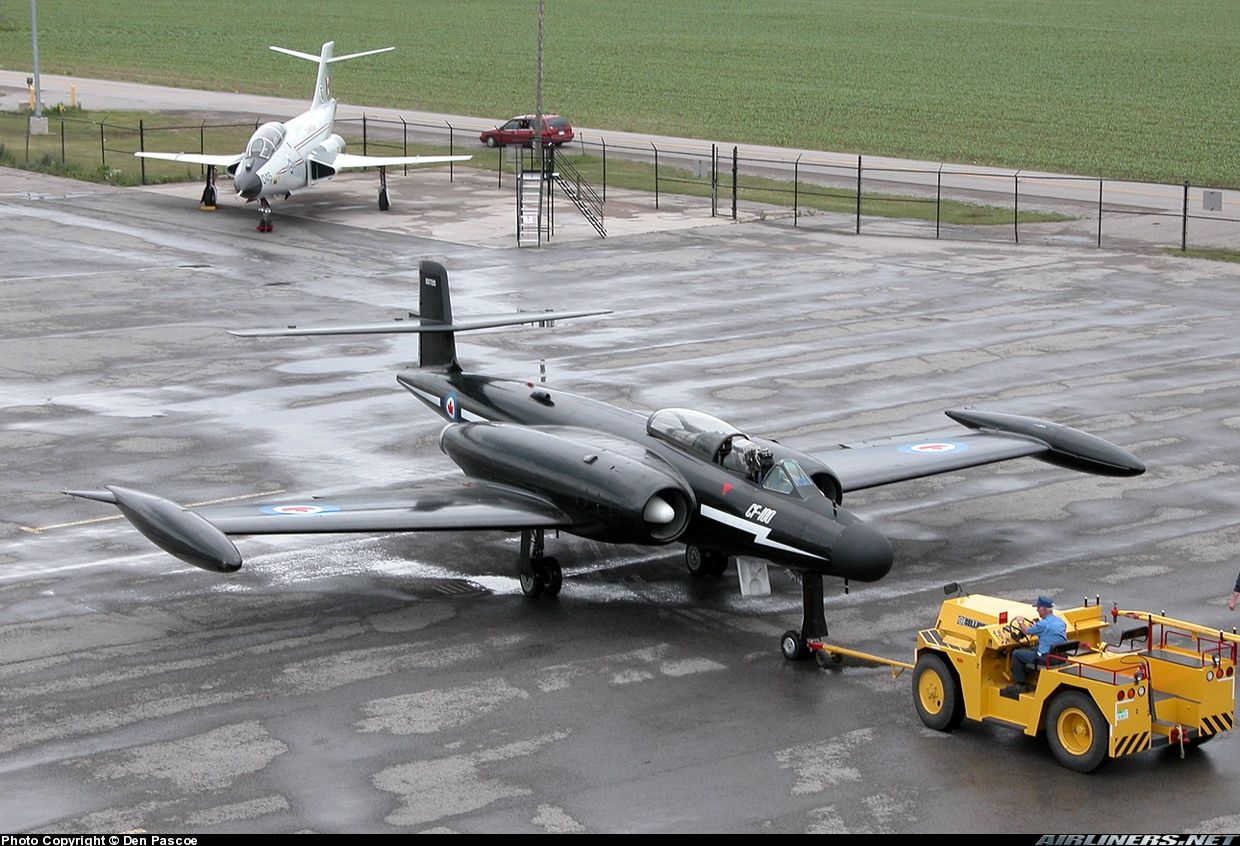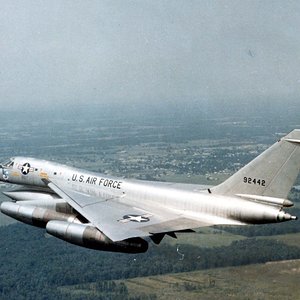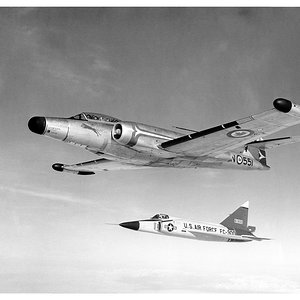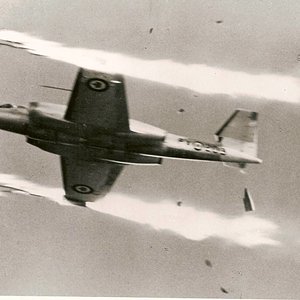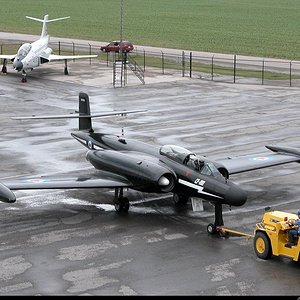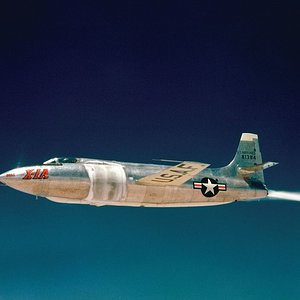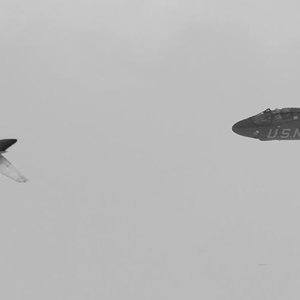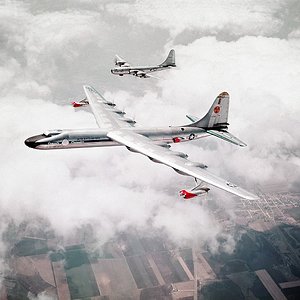Navigation
Install the app
How to install the app on iOS
Follow along with the video below to see how to install our site as a web app on your home screen.
Note: This feature may not be available in some browsers.
More options
You are using an out of date browser. It may not display this or other websites correctly.
You should upgrade or use an alternative browser.
You should upgrade or use an alternative browser.
Design and development
In the early 1950s, Canada needed an all-weather interceptor (fighter) able to patrol the vast areas of Canada's north and operate in all weather conditions. The two-seat fighter crewed by a pilot and navigator was designed with two powerful engines and an advanced radar and fire control system housed in its nose that enabled it to fly in all-weather or night conditions.
CF-100 Mk 4B in a "scramble" from RCAF St. Hubert, Quebec, c. 1962
CF-100 MK 5D (18476) former CFB Namao and No. 414 Electronic Warfare (EW) Squadron #100476 painted as No. 440 Squadron RCAF Mk 4B serving in NATO and on display at the Alberta Aviation Museum.
Design of the XC-100 to meet a Royal Canadian Air Force (RCAF) specification for an all-weather fighter was initiated at Avro Canada in October 1946. Chief Engineer Edgar Atkin's work on the CF-100 was subsequently passed to John Frost (formerly of de Havilland) who, along with Avro's Chief Aerodynamacist Jim Chamberlin, reworked the original fuselage design. The CF-100 Mark 1 prototype, "18101," emerged out of the factory, painted gloss black overall with white lightning bolts running down the fuselage and engines. The CF-100 prototype flew its maiden flight on 19 January 1950 with Gloster Aircraft Company Chief Test Pilot Squadron Leader Bill Waterton at the controls. Waterton was on loan from the Gloster firm, another member of the Hawker Siddeley Group, and chosen because of his experience with jet aircraft development, as one of the "highest-time" pilots in the world. [1] The Mark 1 was powered by two Avon RA 3 turbojets with 28.9 kN (2,950 kgp / 6,500 lbf) thrust each.
The second prototype, 18102, was also powered by Rolls-Royce Avons, although subsequent pre-production and production series aircraft used the Avro Orenda turbojet. Five pre-production Mk 2 test aircraft were produced (18103-18107) all fitted with the Orenda 2 jet engines; one was fitted with dual controls and designated a Mk 2T trainer. The first production version, designated Mk 3, incorporated the APG-33 radar and was armed with eight .50 caliber (12.7 mm) machine guns. The Mk 3CT and Mk 3DT were again dual control versions supplied to operational training units.
Specifications (CF-100 Mk 5)
General characteristics
Crew: 2, pilot and navigator
Length: 16.5 m (54 ft 2 in)
Wingspan: 17.4 m (57 ft 2 in)
Height: 4.4 m (14 ft 6 in)
Wing area: 54.9 m² (591 ft²)
Empty weight: 10,500 kg (23,100 lb)
Loaded weight: 15,170 kg (33,450 lb)
Powerplant: 2 × Avro Canada Orenda 11 turbojets, 32.5 kN (7,300 lbf) each
Performance
Maximum speed: 888 km/h (552 mph)
Range: 3,200km (2,000mi)
Service ceiling: 13,700 m (45,000 ft)
Rate of climb: 44.5 m/s (8,750 ft/min)
Wing loading: kg/m² (lb/ft²)
Thrust/weight: 0.44
Armament
2 wingtip pods of 29 x 70-mm (2.75 in) "Mighty Mouse" fin-folding aerial rockets
In the early 1950s, Canada needed an all-weather interceptor (fighter) able to patrol the vast areas of Canada's north and operate in all weather conditions. The two-seat fighter crewed by a pilot and navigator was designed with two powerful engines and an advanced radar and fire control system housed in its nose that enabled it to fly in all-weather or night conditions.
CF-100 Mk 4B in a "scramble" from RCAF St. Hubert, Quebec, c. 1962
CF-100 MK 5D (18476) former CFB Namao and No. 414 Electronic Warfare (EW) Squadron #100476 painted as No. 440 Squadron RCAF Mk 4B serving in NATO and on display at the Alberta Aviation Museum.
Design of the XC-100 to meet a Royal Canadian Air Force (RCAF) specification for an all-weather fighter was initiated at Avro Canada in October 1946. Chief Engineer Edgar Atkin's work on the CF-100 was subsequently passed to John Frost (formerly of de Havilland) who, along with Avro's Chief Aerodynamacist Jim Chamberlin, reworked the original fuselage design. The CF-100 Mark 1 prototype, "18101," emerged out of the factory, painted gloss black overall with white lightning bolts running down the fuselage and engines. The CF-100 prototype flew its maiden flight on 19 January 1950 with Gloster Aircraft Company Chief Test Pilot Squadron Leader Bill Waterton at the controls. Waterton was on loan from the Gloster firm, another member of the Hawker Siddeley Group, and chosen because of his experience with jet aircraft development, as one of the "highest-time" pilots in the world. [1] The Mark 1 was powered by two Avon RA 3 turbojets with 28.9 kN (2,950 kgp / 6,500 lbf) thrust each.
The second prototype, 18102, was also powered by Rolls-Royce Avons, although subsequent pre-production and production series aircraft used the Avro Orenda turbojet. Five pre-production Mk 2 test aircraft were produced (18103-18107) all fitted with the Orenda 2 jet engines; one was fitted with dual controls and designated a Mk 2T trainer. The first production version, designated Mk 3, incorporated the APG-33 radar and was armed with eight .50 caliber (12.7 mm) machine guns. The Mk 3CT and Mk 3DT were again dual control versions supplied to operational training units.
Specifications (CF-100 Mk 5)
General characteristics
Crew: 2, pilot and navigator
Length: 16.5 m (54 ft 2 in)
Wingspan: 17.4 m (57 ft 2 in)
Height: 4.4 m (14 ft 6 in)
Wing area: 54.9 m² (591 ft²)
Empty weight: 10,500 kg (23,100 lb)
Loaded weight: 15,170 kg (33,450 lb)
Powerplant: 2 × Avro Canada Orenda 11 turbojets, 32.5 kN (7,300 lbf) each
Performance
Maximum speed: 888 km/h (552 mph)
Range: 3,200km (2,000mi)
Service ceiling: 13,700 m (45,000 ft)
Rate of climb: 44.5 m/s (8,750 ft/min)
Wing loading: kg/m² (lb/ft²)
Thrust/weight: 0.44
Armament
2 wingtip pods of 29 x 70-mm (2.75 in) "Mighty Mouse" fin-folding aerial rockets

